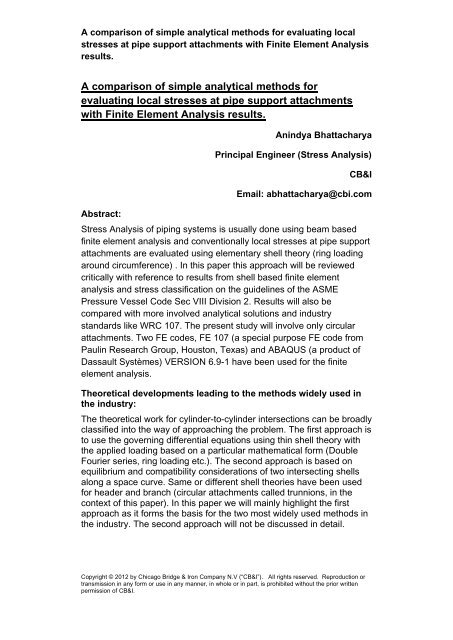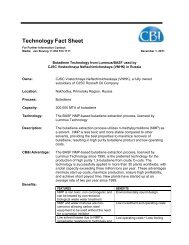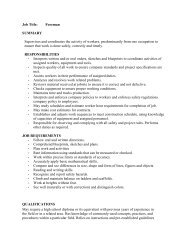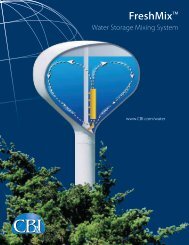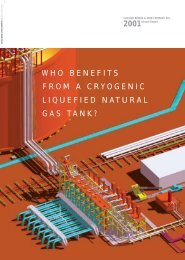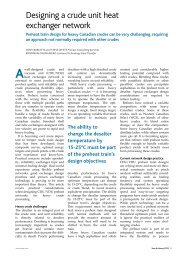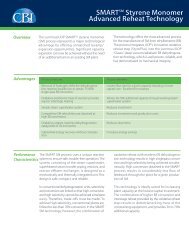A comparison of simple analytical methods for evaluating local - CB&I
A comparison of simple analytical methods for evaluating local - CB&I
A comparison of simple analytical methods for evaluating local - CB&I
You also want an ePaper? Increase the reach of your titles
YUMPU automatically turns print PDFs into web optimized ePapers that Google loves.
A <strong>comparison</strong> <strong>of</strong> <strong>simple</strong> <strong>analytical</strong> <strong>methods</strong> <strong>for</strong> <strong>evaluating</strong> <strong>local</strong>stresses at pipe support attachments with Finite Element Analysisresults.A <strong>comparison</strong> <strong>of</strong> <strong>simple</strong> <strong>analytical</strong> <strong>methods</strong> <strong>for</strong><strong>evaluating</strong> <strong>local</strong> stresses at pipe support attachmentswith Finite Element Analysis results.Abstract:Anindya BhattacharyaPrincipal Engineer (Stress Analysis)CB&IEmail: abhattacharya@cbi.comStress Analysis <strong>of</strong> piping systems is usually done using beam basedfinite element analysis and conventionally <strong>local</strong> stresses at pipe supportattachments are evaluated using elementary shell theory (ring loadingaround circumference) . In this paper this approach will be reviewedcritically with reference to results from shell based finite elementanalysis and stress classification on the guidelines <strong>of</strong> the ASMEPressure Vessel Code Sec VIII Division 2. Results will also becompared with more involved <strong>analytical</strong> solutions and industrystandards like WRC 107. The present study will involve only circularattachments. Two FE codes, FE 107 (a special purpose FE code fromPaulin Research Group, Houston, Texas) and ABAQUS (a product <strong>of</strong>Dassault Systèmes) VERSION 6.9-1 have been used <strong>for</strong> the finiteelement analysis.Theoretical developments leading to the <strong>methods</strong> widely used inthe industry:The theoretical work <strong>for</strong> cylinder-to-cylinder intersections can be broadlyclassified into the way <strong>of</strong> approaching the problem. The first approach isto use the governing differential equations using thin shell theory withthe applied loading based on a particular mathematical <strong>for</strong>m (DoubleFourier series, ring loading etc.). The second approach is based onequilibrium and compatibility considerations <strong>of</strong> two intersecting shellsalong a space curve. Same or different shell theories have been used<strong>for</strong> header and branch (circular attachments called trunnions, in thecontext <strong>of</strong> this paper). In this paper we will mainly highlight the firstapproach as it <strong>for</strong>ms the basis <strong>for</strong> the two most widely used <strong>methods</strong> inthe industry. The second approach will not be discussed in detail.Copyright © 2012 by Chicago Bridge & Iron Company N.V (“CB&I”). All rights reserved. Reproduction ortransmission in any <strong>for</strong>m or use in any manner, in whole or in part, is prohibited without the prior writtenpermission <strong>of</strong> CB&I.
A <strong>comparison</strong> <strong>of</strong> <strong>simple</strong> <strong>analytical</strong> <strong>methods</strong> <strong>for</strong> <strong>evaluating</strong> <strong>local</strong>stresses at pipe support attachments with Finite Element Analysisresults.We will start with the method usually known as the “Kellogg method;” itsorigin can be traced in [3]. Since the method has its origin in the theory<strong>of</strong> thin shells, we will refer to it as Timoshenko method in this paperThe “Kellogg” (Timoshenko) method:Governing differential equation: [1]For an Axi-symmetric loading on a circular cylinder, the governingdifferential equation is the well known beam on elastic foundationequation:4d w+ Kw = ZDdx4(1)where,D, is the Flexural Rigidity <strong>of</strong> the shellw = deflection in vertical DOFx = Direction <strong>of</strong> Longitudinal axis <strong>of</strong> the cylinderZ = load in vertical directionK = Foundation stiffness,rEt2E = Modulus <strong>of</strong> elasticityt = Shell thickness.r =Shell mid-surface radius4d w Etw+ =4 2Drdx3EtD =212(1 − µ )ZDwhere • = Poisson’s ratio(2)Introducingβwe there<strong>for</strong>e get24 3(1 − µ ) 1.28= i.e. β = considering • = 0.32 2rtrtCopyright © 2012 by Chicago Bridge & Iron Company N.V (“CB&I”). All rights reserved. Reproduction ortransmission in any <strong>for</strong>m or use in any manner, in whole or in part, is prohibited without the prior writtenpermission <strong>of</strong> CB&I.
A <strong>comparison</strong> <strong>of</strong> <strong>simple</strong> <strong>analytical</strong> <strong>methods</strong> <strong>for</strong> <strong>evaluating</strong> <strong>local</strong>stresses at pipe support attachments with Finite Element Analysisresults.4d w 4 Z+ 4β w =(3)4dxDThe solution <strong>of</strong> this differential equation and boundary conditions aredetailed in [1]Extending the above analysis to a case <strong>of</strong> bending <strong>of</strong> a cylindrical shellby a load uni<strong>for</strong>mly distributed along a circular section [1], we get:PMaximum Bending Moment = , where P= load per unit circumference4βapplied through the ring <strong>of</strong> load.0.5Bending stress σ 1.17 Prbending = 1.5t(4)P can be defined in terms <strong>of</strong> a <strong>local</strong> radial load, P r , and <strong>local</strong> momentM r . This is necessary because P is a line load distributed around thecircumference <strong>of</strong> the shell.If a load P r is divided by the attachment perimeter it becomesr<strong>for</strong>2πrna nozzle <strong>of</strong> radius r n . Or a Moment divided by the Section modulus <strong>of</strong>M rthe attachment becomes2πrnFlexural stresses are added to membrane longitudinal and hoopstresses to get total stress = membrane stress in direction i + flexuralstresses in direction i computed by the expression in equation (4)To compute P, the steps to be followed are:• Computation <strong>of</strong> loads in longitudinal and circumferentialdirections by use <strong>of</strong> the following expressions:• Longitudinal <strong>for</strong>ce = (Longitudinal <strong>for</strong>ce x moment arm)/πr 2Where r = radius <strong>of</strong> Trunnion• Circumferential <strong>for</strong>ce = (Circumferential <strong>for</strong>ce x moment arm)/πr 2• Radial <strong>for</strong>ce = Radial Load /2πr• Equivalent circumferential <strong>for</strong>ce = 2 x Circ <strong>for</strong>ce +1.5xRadial<strong>for</strong>cePCopyright © 2012 by Chicago Bridge & Iron Company N.V (“CB&I”). All rights reserved. Reproduction ortransmission in any <strong>for</strong>m or use in any manner, in whole or in part, is prohibited without the prior writtenpermission <strong>of</strong> CB&I.
A <strong>comparison</strong> <strong>of</strong> <strong>simple</strong> <strong>analytical</strong> <strong>methods</strong> <strong>for</strong> <strong>evaluating</strong> <strong>local</strong>stresses at pipe support attachments with Finite Element Analysisresults.• Equivalent longitudinal <strong>for</strong>ce = 1.5 x Radial <strong>for</strong>ce +LongitudinalForceThe above <strong>for</strong>ces are used as P in equation (4)The reason behind the use <strong>of</strong> the factors 1.5 and 2.0 is attributed tohigher flexibilities in these directions.The flexural stresses in longitudinal and circumferential directions arethen computed using these “equivalent” <strong>for</strong>ces and the membranepressure stresses are then added to compute the total stresses.M FStresses in the Trunnion attachment is computed as + where M=Z AResultant applied bending moment (square root <strong>of</strong> squares <strong>of</strong> thebending moments in longitudinal and circumferential directions) and F isthe applied radial <strong>for</strong>ce. Z and A are the section modulus and crosssectional areas respectively <strong>of</strong> the trunnion pipe.Points to note about the background theory and about the way theabove method is typically implemented in engineering designusing spreadsheets:t• Use <strong>of</strong> thin shell theory ( < 1 )r 10• Axi-symmetric loading• Simple approach in specifying the loads are the main features <strong>of</strong>this method• Stresses in the circular attachment computed by elementarybeam theory and not shell theory• Pl+Pb+Q [16] computed as a superposition <strong>of</strong> flexural stressesusing beam on elastic foundation theory with the membranestresses computed using elementary strength <strong>of</strong> materials<strong>for</strong>mulas.• Computation <strong>for</strong> fatigue stresses (Pl+Pb+Q+F)[16] is usually notdone using spreadsheets. This is not an inherent problem withthe background theory; it has to do with the way the method isusually implemented in spreadsheets.• Multiplication factors used in circumferential and radial directionsto simulate higher stresses in these directions [11] attribute tohigher flexibilities in these directions.Copyright © 2012 by Chicago Bridge & Iron Company N.V (“CB&I”). All rights reserved. Reproduction ortransmission in any <strong>for</strong>m or use in any manner, in whole or in part, is prohibited without the prior writtenpermission <strong>of</strong> CB&I.
A <strong>comparison</strong> <strong>of</strong> <strong>simple</strong> <strong>analytical</strong> <strong>methods</strong> <strong>for</strong> <strong>evaluating</strong> <strong>local</strong>stresses at pipe support attachments with Finite Element Analysisresults.more suited. Loading on the pipe is idealised as radial load,longitudinal moment, circumferential moment, shear <strong>for</strong>ce etc., hencethe nozzles, as an example, are not part <strong>of</strong> the <strong>analytical</strong> model in thiscase. WRC 107 was developed based on Bijlaard’s theoretical worksupplemented with experimental works. This document provides a set<strong>of</strong> curves based on non-dimensional parameters on which stressescould be computed along four different points around the loadingcircumference.Development <strong>of</strong> the theoretical work <strong>for</strong> WRC 107[5]:The historical development leading to Bijlaard’s work can besummarized as: Differential equation <strong>for</strong> cylindrical shell subjected togeneral loading (Donnel) → Modifications by Yuan → Modifications byP.P.Bijlaard.Donnel’s equation [19] is quite <strong>simple</strong> and its homogeneous equationcan be expressed in complex valued displacement stress function <strong>for</strong>m,it can be decomposed into two second order partial differentialequations and is easy to solve in polar coordinate system <strong>for</strong> thecylindrical shell with cut out [19].Bijlaard’s equations [5] which are the theoretical basis <strong>for</strong> WRC 107[8]are:Copyright © 2012 by Chicago Bridge & Iron Company N.V (“CB&I”). All rights reserved. Reproduction ortransmission in any <strong>for</strong>m or use in any manner, in whole or in part, is prohibited without the prior writtenpermission <strong>of</strong> CB&I.
A <strong>comparison</strong> <strong>of</strong> <strong>simple</strong> <strong>analytical</strong> <strong>methods</strong> <strong>for</strong> <strong>evaluating</strong> <strong>local</strong>stresses at pipe support attachments with Finite Element Analysisresults.2 4 6 68 12(1 −µ) ∂ w 2 ∂ w 2 ∂ w∇ w + + [ + (6 + µ −µ)tr ∂x r ∂θr ∂x∂θ6 4∂ w ∇ Z+ (7 + µ ) ] =4 2 4r ∂x ∂θD2 2 4 6 6 2 4 22 2 2 5 54 ∂ w ∂ w 1+ µ t ∂ w ∂ w−∇ r u = µ − + ( + )2 2 2 2 2 2 2 4∂x r ∂x∂θ 1−µ 12r ∂u ∂θ r ∂x∂θ3 2 2 54∂ w ∂ w t 2r ∂ w−∇ r v = (2 + µ ) +[2 2 2 2 4r∂x ∂θ r ∂θ −12r 1−µµ ∂x∂θ5 53 −µ∂ w ∂ w+ +(1 −µ ) r ∂x ∂θ r ∂θ2 3 3 3](5)(6)(7)where,w, is displacement in radial direction,u and v, are displacements along x and y direction respectivelyon the middle surface,θ, the circumferential angler, radius <strong>of</strong> cylindert, shell thicknessµ, Poisson ratio∇ = Del OperatorThere can be different approaches to the solution to this equation, butin this paper we will only highlight the approach taken by Bijlaard in hiswork which was to represent the displacements and loadings as doubleFourier series. Fourier coefficients are a function <strong>of</strong> the type <strong>of</strong> loading(radial, circumferential moment and longitudinal moment). The followingdiagrams show the idealisations used by Bijlaard in simulating theapplied loads <strong>for</strong> radial, longitudinal and circumferential moments.Copyright © 2012 by Chicago Bridge & Iron Company N.V (“CB&I”). All rights reserved. Reproduction ortransmission in any <strong>for</strong>m or use in any manner, in whole or in part, is prohibited without the prior writtenpermission <strong>of</strong> CB&I.
A <strong>comparison</strong> <strong>of</strong> <strong>simple</strong> <strong>analytical</strong> <strong>methods</strong> <strong>for</strong> <strong>evaluating</strong> <strong>local</strong>stresses at pipe support attachments with Finite Element Analysisresults.Main features <strong>of</strong> this method:• Thin shell theory• Solid attachment without hole in the pipe wall• Governing differential equations are solved using Double Fourierseries representation <strong>of</strong> loads and displacements. This method iswidely used but convergence may not be possible <strong>for</strong> certainboundary conditions [14]• Simply supported boundary conditions• Central location <strong>of</strong> load application• Load application is through solid attachments and without anyhole on pipe wall• Internal pressure simulation can result in over conservatism• Results usually vary significantly with reference to FE analysisd<strong>for</strong> shear and torsional moment and <strong>for</strong> 0.5 < < 1.0DCopyright © 2012 by Chicago Bridge & Iron Company N.V (“CB&I”). All rights reserved. Reproduction ortransmission in any <strong>for</strong>m or use in any manner, in whole or in part, is prohibited without the prior writtenpermission <strong>of</strong> CB&I.
A <strong>comparison</strong> <strong>of</strong> <strong>simple</strong> <strong>analytical</strong> <strong>methods</strong> <strong>for</strong> <strong>evaluating</strong> <strong>local</strong>stresses at pipe support attachments with Finite Element Analysisresults.Cautions:• Over-conservative behavior if pressure stress is simulated as aradial load• For thick shells the theory requires modification• Results are generally un-conservative <strong>for</strong> shear <strong>for</strong>ce andtorsional moments• Valid range <strong>for</strong> d Dis less than 0.3 so <strong>for</strong> trunnion applicationswhere the size <strong>of</strong> the attached pipe is generally one size smallerthan the header pipe, the background theory is not applicable[12]. This is mainly attributed to the sensitivity <strong>of</strong> the modelling <strong>of</strong>dthe intersecting curve <strong>for</strong> > 0.3 [12]D• Use <strong>of</strong> a linearly distributed radial <strong>for</strong>ce system instead <strong>of</strong> avertical <strong>for</strong>ce system results in a transverse bending momentplus a <strong>for</strong>ce -- a fact not noted in this approach [19]WRC Bulletin 297This was based on the theoretical work <strong>of</strong> Pr<strong>of</strong>essor Steele and thedevelopment <strong>of</strong> equations was based on the works <strong>of</strong> Flugge -Conradand Sanders -Simmonds [10]. The applicable D Twas increased fromthe WRC bulletin <strong>of</strong> 600 to 2500 and the issue <strong>of</strong> nozzle stresses wasincluded, i.e., this approach considered a “true” nozzle opening.However, our present problem does not involve an opening and henceWRC 107 is theoretically more applicable than WRC 297, althoughcomputation <strong>of</strong> the nozzle stresses has been shown in the Resultssection <strong>for</strong> <strong>comparison</strong>.Difficulties in <strong>analytical</strong> solution <strong>of</strong> the problem:The <strong>analytical</strong> models <strong>for</strong> both WRC 107 and 297 are based on thinshell assumptions, so they are not valid <strong>for</strong> thick shell analysis. Bijlaard[7] made changes to his earlier work based on incorporating thick shellcorrections using Flugge equations instead <strong>of</strong> Donnel’s. The otherddifficulty is where > 0.5. The main difficulty is the mathematicalDcomplexity associated with 3D space curve <strong>of</strong> intersections whichcannot be simulated as a circle when d Dis high [11][12][15]) . SeveralCopyright © 2012 by Chicago Bridge & Iron Company N.V (“CB&I”). All rights reserved. Reproduction ortransmission in any <strong>for</strong>m or use in any manner, in whole or in part, is prohibited without the prior writtenpermission <strong>of</strong> CB&I.
A <strong>comparison</strong> <strong>of</strong> <strong>simple</strong> <strong>analytical</strong> <strong>methods</strong> <strong>for</strong> <strong>evaluating</strong> <strong>local</strong>stresses at pipe support attachments with Finite Element Analysisresults.researchers have used different <strong>methods</strong> such as using differential<strong>for</strong>mulations (e.g., use <strong>of</strong> Donnel’s equations <strong>for</strong> header and Fluggeequation[2] <strong>for</strong> branch or Modified Morley equation <strong>for</strong> header andGoldenveizer equation <strong>for</strong> branch[11][12]) . Donnel’s equation which<strong>for</strong>med the starting point <strong>of</strong> Bijlaard’s work has serious deficienciesdwhen used <strong>for</strong> problems with > 0.5. (Figure 6.14 <strong>of</strong> [18])DCopyright © 2012 by Chicago Bridge & Iron Company N.V (“CB&I”). All rights reserved. Reproduction ortransmission in any <strong>for</strong>m or use in any manner, in whole or in part, is prohibited without the prior writtenpermission <strong>of</strong> CB&I.
A <strong>comparison</strong> <strong>of</strong> <strong>simple</strong> <strong>analytical</strong> <strong>methods</strong> <strong>for</strong> <strong>evaluating</strong> <strong>local</strong>stresses at pipe support attachments with Finite Element Analysisresults.Challenges in FEA:The issue <strong>of</strong> classification <strong>of</strong> the FE computed stresses on the line <strong>of</strong>[16] has been dealt with in numerous papers [20] [16] and will not berepeated here. In a nutshell, <strong>local</strong> membrane stresses are designatedas Pl, primary + secondary stresses as Pl+Pb+Q and peak stresses asPl+Pb+Q+F in line with [16]. Primary stresses develop to maintainequilibrium with external loads, secondary stresses to maintaincompatibility <strong>of</strong> de<strong>for</strong>mation (global) and peak stresses to maintaincompatibility <strong>of</strong> <strong>local</strong> de<strong>for</strong>mation. Pl stands <strong>for</strong> <strong>local</strong> primary stress, Pb<strong>for</strong> primary bending stress, Q <strong>for</strong> secondary stress and F <strong>for</strong> peakstress. Peak stresses are significant only from the standpoint <strong>of</strong> fatiguefailure.Elements used <strong>for</strong> FE analysis are 8-node reduced integration shellelements as well as 20-node reduced integration brick elements. Forthe continuum elements, membrane and bending stresses have beensegregated using linearization. The shell element has shown goodresults in applications involving cylinder-to-cylinder interactionsspecially when compared with 20-node hexahedral elements withreduced integration. The same element has been used in two FE codes(ABAQUS element type S8R). FE theory convergence theorems are inL or 2 H norms which are difficult to implement when the exact1solution is not shown and in this paper no attempt has been made toevaluate the convergence using these norms. For checking theconvergence <strong>of</strong> an FE model, percentage change in stress isconsidered from a model with very fine mesh to gradually crudermodels. Stresses are checked at Gauss points <strong>for</strong> accuracy andunaveraged. For convergence, monotonic behavior is checked with amaximum permissible variation in stress taken as 5%.The mesh sizearound the intersection is taken as 0.3 rt with progressive meshgrading away from it. For continuum elements four elements have beenused through the thickness at and close to intersections. The objective<strong>of</strong> the FE analysis was not to catch the peak stresses which are used<strong>for</strong> fatigue evaluation, as once the Pl+Pb+Q stresses are computed, thefatigue stresses can be computed using Fatigue Strength ReductionFactors (FSRF) [16]. The paper referenced in [17] shows that modelling<strong>of</strong> welds to properly simulate joint stiffness does not have seriousimpact on the computed stresses and hence, welds are not part <strong>of</strong> themodel. To avoid end effect, the location <strong>of</strong> the trunnion has been takenCopyright © 2012 by Chicago Bridge & Iron Company N.V (“CB&I”). All rights reserved. Reproduction ortransmission in any <strong>for</strong>m or use in any manner, in whole or in part, is prohibited without the prior writtenpermission <strong>of</strong> CB&I.
A <strong>comparison</strong> <strong>of</strong> <strong>simple</strong> <strong>analytical</strong> <strong>methods</strong> <strong>for</strong> <strong>evaluating</strong> <strong>local</strong>stresses at pipe support attachments with Finite Element Analysisresults.as 5D [13] with respect to the end <strong>of</strong> the header. The worst aspect ratioaround the intersection (HEX elements) was 6.0, average aspect ratio2.0. One end <strong>of</strong> the header was fixed in all six DOFs and the other endis fixed in five DOFs, the DOF along the longitudinal axis <strong>of</strong> the headerwas kept free to generate longitudinal pressure stress (<strong>for</strong> modelswhere pressure was applied). Linear and full integration elements werenot used to avoid shear locking.ResultsMesh around the intersection curve using HEX elementsCopyright © 2012 by Chicago Bridge & Iron Company N.V (“CB&I”). All rights reserved. Reproduction ortransmission in any <strong>for</strong>m or use in any manner, in whole or in part, is prohibited without the prior writtenpermission <strong>of</strong> CB&I.
A <strong>comparison</strong> <strong>of</strong> <strong>simple</strong> <strong>analytical</strong> <strong>methods</strong> <strong>for</strong> <strong>evaluating</strong> <strong>local</strong>stresses at pipe support attachments with Finite Element Analysisresults.Von Mises plot (30x24 HEX elements)In the WRC 107/297 method, the length <strong>of</strong> the nozzle is not aparameter and in all tables below, the loads have been applied in theFE model at the end <strong>of</strong> the nozzle, i.e., the trunnion which in the WRC107 /297 cases will be a <strong>for</strong>ce and a moment <strong>for</strong> obvious reasons. In aseparate table <strong>comparison</strong> <strong>of</strong> stresses between WRC 107/297 and FEAhas been shown with the loads applied at the shell-nozzle interface.The stresses are Membrane+Bending; with the Timoshenko method thecomputation is <strong>for</strong> flexural stresses only using equation (4). WRC 107and 297 results are the maximum among the four locations specified inthese documents [8 ] [9]. Computed stresses are in Mpa and are themaximum values rounded to the next integer (some exceptions beingstresses at trunnions).Copyright © 2012 by Chicago Bridge & Iron Company N.V (“CB&I”). All rights reserved. Reproduction ortransmission in any <strong>for</strong>m or use in any manner, in whole or in part, is prohibited without the prior writtenpermission <strong>of</strong> CB&I.
A <strong>comparison</strong> <strong>of</strong> <strong>simple</strong> <strong>analytical</strong> <strong>methods</strong> <strong>for</strong> <strong>evaluating</strong> <strong>local</strong>stresses at pipe support attachments with Finite Element Analysisresults.(30 inch header, 24 inch trunnion,. wall thickness =9.52 mm <strong>for</strong> both)Magnitude <strong>of</strong> Force =10KN, length <strong>of</strong> trunnion =100 mm, d/D=0.8,t/T=1):Loading TypeRadialForceWRC 107ShellWRC 107 Trunnion45 N.A.WRC 297 ShellWRC 297 TrunnionTimoshenkoShellTimoshenko TrunnionFEA Shell element (Shell)FEA Shell elements (Trunnion)FEA Continuum elements (Shell)FEA Continuum elements(Nozzle)50 54 6 0.6 10 15 9 12LongitudinalForce3 N.A6 6 3 0.4 6 5 5 3CircumferentialForce16 N.A22 20 5 0.4 3 6 3 6Copyright © 2012 by Chicago Bridge & Iron Company N.V (“CB&I”). All rights reserved. Reproduction ortransmission in any <strong>for</strong>m or use in any manner, in whole or in part, is prohibited without the prior writtenpermission <strong>of</strong> CB&I.
A <strong>comparison</strong> <strong>of</strong> <strong>simple</strong> <strong>analytical</strong> <strong>methods</strong> <strong>for</strong> <strong>evaluating</strong> <strong>local</strong>stresses at pipe support attachments with Finite Element Analysisresults.Results (36 inch header, 30 inch trunnion,. wall thickness =9.52 mm <strong>for</strong>both) Magnitude <strong>of</strong> Force =10KN, length <strong>of</strong> trunnion =100 mm,d/D=0.84, t/T=1)Loading TypeRadialForceWRC 107ShellWRC 107 TrunnionWRC 297 ShellWRC 297 TrunnionTimoshenkoShellTimoshenko Trunnion45 N.A 51 56 6 0.44 21 15 19 15FEA Shell element (Shell)FEA Shell elements (Trunnion)FEA Continuum elements (Shell)FEA Continuum elements (Nozzle)LongitudinalForceCircumferentialForce2 N.A 5 4 2 0.2 7 5 6 612 N.A 17 16 4 0.2 5 4 4 5Copyright © 2012 by Chicago Bridge & Iron Company N.V (“CB&I”). All rights reserved. Reproduction ortransmission in any <strong>for</strong>m or use in any manner, in whole or in part, is prohibited without the prior writtenpermission <strong>of</strong> CB&I.
A <strong>comparison</strong> <strong>of</strong> <strong>simple</strong> <strong>analytical</strong> <strong>methods</strong> <strong>for</strong> <strong>evaluating</strong> <strong>local</strong>stresses at pipe support attachments with Finite Element Analysisresults.Results (36 inch header, 12 inch trunnion, and wall thickness =9.52 mm<strong>for</strong> header and 6.35 mm <strong>for</strong> trunnion) Magnitude <strong>of</strong> Force =10KN,length <strong>of</strong> trunnion =100 mm, d/D=0.34, t/T=0.67):Loading TypeRadialForceWRC 107ShellWRC 107 Trunnion48 N.AWRC 297 ShellWRC 297 TrunnionTimoshenkoShellTimoshenko TrunnionFEA Shell element (Shell)FEA Shell elements (Trunnion)FEA Continuum elements (Shell)FEA Continuum elements(Nozzle)54 103 15 2 46 48 44 46LongitudinalForce10 N.A16 30 11 2 16 16 13 14CircumferentialForce31 N.A41 75 22 2 29 31 27 29Copyright © 2012 by Chicago Bridge & Iron Company N.V (“CB&I”). All rights reserved. Reproduction ortransmission in any <strong>for</strong>m or use in any manner, in whole or in part, is prohibited without the prior writtenpermission <strong>of</strong> CB&I.
A <strong>comparison</strong> <strong>of</strong> <strong>simple</strong> <strong>analytical</strong> <strong>methods</strong> <strong>for</strong> <strong>evaluating</strong> <strong>local</strong>stresses at pipe support attachments with Finite Element Analysisresults.Results (24 inch header, 20 inch trunnion, and wall thickness =9.52 mmheader and 6.35 mm <strong>for</strong> trunnion) Magnitude <strong>of</strong> Force =10KN, length <strong>of</strong>trunnion =100 mm, d/D=0.84, t/T=0.67):Loading TypeRadialForceWRC 107 ShellWRC 107 TrunnionWRC 297 ShellWRC 297 TrunnionTimoshenko ShellTimoshenko TrunnionFEA Shell element (Shell)FEA Shell elements(Trunnion)FEA Continuumelements(Shell)FEA Continuum elements(Nozzle)44 N.A 44 90 7 1 19 20 17 19LongitudinalForceCircumferentialForce5 N.A 7 13 4 1 10 9 11 820 N.A 23 44 7 1 6 7 6 6Copyright © 2012 by Chicago Bridge & Iron Company N.V (“CB&I”). All rights reserved. Reproduction ortransmission in any <strong>for</strong>m or use in any manner, in whole or in part, is prohibited without the prior writtenpermission <strong>of</strong> CB&I.
A <strong>comparison</strong> <strong>of</strong> <strong>simple</strong> <strong>analytical</strong> <strong>methods</strong> <strong>for</strong> <strong>evaluating</strong> <strong>local</strong>stresses at pipe support attachments with Finite Element Analysisresults.Results (24 inch header, 8 inch trunnion, and wall thickness =9.52 mmheader and 8.18 mm <strong>for</strong> trunnion) Magnitude <strong>of</strong> Force =10KN, length <strong>of</strong>trunnion =100 mm, d/D=0.36, t/T=0.86):Loading TypeRadialForceWRC 107ShellWRC 107 Trunnion47 N.AWRC 297 ShellWRC 297 TrunnionTimoshenkoShellTimoshenko TrunnionFEA Shell element(Shell)FEA Shell elements(Trunnion)FEA Continuumelements (Shell)FEA Continuumelements (Nozzle)69 74 16 2 48 43 46 41LongitudinalForce21N.A31 34 20 4 26 21 24 19CircumferentialForce53 N.A77 78 40 4 46 43 44 43Copyright © 2012 by Chicago Bridge & Iron Company N.V (“CB&I”). All rights reserved. Reproduction ortransmission in any <strong>for</strong>m or use in any manner, in whole or in part, is prohibited without the prior writtenpermission <strong>of</strong> CB&I.
A <strong>comparison</strong> <strong>of</strong> <strong>simple</strong> <strong>analytical</strong> <strong>methods</strong> <strong>for</strong> <strong>evaluating</strong> <strong>local</strong>stresses at pipe support attachments with Finite Element Analysisresults.36 inch header and 12 inch trunnion loads applied at shell nozzleinterface (Moment=10KN-m and Force=10KN (wall thickness <strong>of</strong> shell=9.52mm, trunnion = 6.35 mm, d/D=0.34, t/T=0.67)Loading TypeLongitudinalmomentWRC 107ShellWRC 107 TrunnionWRC 297 ShellWRC 297 TrunnionFEA Shell element (Shell)FEA Shell elements (Trunnion)99 N.A 153 295 108 105Circumferentialmoment310 N.A 413 752 363 401Radial <strong>for</strong>ce 48 N.A 54 103 46 48Shear Force(long)Shear <strong>for</strong>ce(circ)TorsionalMoment4 N.A 4 6 6 74 N.A 4 6 10 913 N.A 13 19 21 23Copyright © 2012 by Chicago Bridge & Iron Company N.V (“CB&I”). All rights reserved. Reproduction ortransmission in any <strong>for</strong>m or use in any manner, in whole or in part, is prohibited without the prior writtenpermission <strong>of</strong> CB&I.
A <strong>comparison</strong> <strong>of</strong> <strong>simple</strong> <strong>analytical</strong> <strong>methods</strong> <strong>for</strong> <strong>evaluating</strong> <strong>local</strong>stresses at pipe support attachments with Finite Element Analysisresults.For the following tables, applied load in longitudinal,circumferential and radial directions =10KN, pressure =18.9Barg.For the WRC 107 analysis, pressure loading has NOT been addedas a radial loading at the trunnion attachment.(30 inch header, 24 inch trunnion, wall thickness =9.52 mm <strong>for</strong> both)WRC107ShellWRC 107TrunnionTimoshenkoShellTimoshenkoTrunnionFEA (shellelements),ShellFEA (shellelements),Trunnion258 N.A 87 1 121 63(36 inch header, 30 inch trunnion, wall thickness =9.52 mm <strong>for</strong> both)WRC107ShellWRC 107TrunnionTimoshenkoShellTimoshenkoTrunnionFEA (shellelements),ShellFEA (shellelements),Trunnion307 N.A 100 0.8 146 7536 inch header, 12 inch trunnion, wall thickness =9.52 mm <strong>for</strong> headerand 6.35 mm <strong>for</strong> trunnionWRC107ShellWRC 107TrunnionTimoshenkoShellTimoshenkoTrunnionFEA (shellelements),ShellFEA (shellelements),Trunnion321 N.A 125 4 170 105Discussions and conclusions:WRC 107 results may be higher or lower with respect to FEA results.Flexural stresses based on <strong>analytical</strong> solution using axi-symmetric ringloading are not significantly in error when compared with FEA as longas the applied loading is not radial. Stresses due to applied loading incircumferential direction are higher when compared with stresses due toapplied longitudinal <strong>for</strong>ce. This trend, however, is always valid when theCopyright © 2012 by Chicago Bridge & Iron Company N.V (“CB&I”). All rights reserved. Reproduction ortransmission in any <strong>for</strong>m or use in any manner, in whole or in part, is prohibited without the prior writtenpermission <strong>of</strong> CB&I.
A <strong>comparison</strong> <strong>of</strong> <strong>simple</strong> <strong>analytical</strong> <strong>methods</strong> <strong>for</strong> <strong>evaluating</strong> <strong>local</strong>stresses at pipe support attachments with Finite Element Analysisresults.trunnion length is around 4d, something that is typically not expected ina real life scenario where the shortest trunnion length is preferred.Be<strong>for</strong>e FE analysis results are compared against <strong>analytical</strong> (including<strong>analytical</strong> +experimental works like WRC 107/297), the basis behind the<strong>analytical</strong> <strong>methods</strong> has to be understood, i.e., the governing differentialequations, solution <strong>methods</strong>, boundary conditions and the underlyingshell theory. The above <strong>methods</strong> such as Timoshenko, Bijlaard andSteele are based on assumptions relating to a specific shell theory andboundary conditions and hence the FE solution should not beconsidered as a numerical counterpart to the <strong>analytical</strong> solutions, i.e.,we should not expect the FE solution to monotonically approach theabove solutions with mesh refinement unless the geometry and loadingare the same. This is especially in view <strong>of</strong> the fact that the underlyingtheory used in the development <strong>of</strong> the 8-node reduced integration shellelement (degenerated shell element, a development <strong>of</strong> the originalAhmad element) is not exactly in line with the shell theory used inBijlaard’s ( WRC 107) or Steele’s ( WRC 297) work. WRC 107/297 arebased on thin shell theories and are not valid <strong>for</strong> geometries where d/Dis >0.5, which is the most common case <strong>for</strong> trunnion attachments,hence the results should not be used <strong>for</strong> d/D>0.5.The results <strong>of</strong> theseanalyses can, however, be used <strong>for</strong> checking the correctness <strong>of</strong> an FEAanalysis <strong>for</strong> d/D
A <strong>comparison</strong> <strong>of</strong> <strong>simple</strong> <strong>analytical</strong> <strong>methods</strong> <strong>for</strong> <strong>evaluating</strong> <strong>local</strong>stresses at pipe support attachments with Finite Element Analysisresults.hand, but in <strong>comparison</strong> with FEA, a component-by-componentanalysis has shown that the computation <strong>of</strong> Pl+Pb+Q stresses atintersections is not grossly incorrect as long as the applied load is not aradial one where stresses are significantly underpredicted. This methodis widely used in the industry in “spreadsheet <strong>for</strong>m” with a conservativeallowable equal to the allowable <strong>for</strong> <strong>local</strong> primary membrane stresses(Pl) and <strong>local</strong> primary membrane +primary bending ( Pl+Pb) which is1.5Sh <strong>for</strong> the stresses which by and large should be in Pl+Pb+Qcategory i.e., with an allowable <strong>of</strong> 3Sm [16]. This conservative allowableirons out the un-conservatism in computation <strong>of</strong> flexural stresses. Theresults <strong>of</strong> these spreadsheets should include computation <strong>of</strong>Pl+Pb+Q+F stresses which can easily be incorporated by using FatigueStrength Reduction Factors. Shell-based analysis (8-node reducedintegration shell elements have shown good results when comparedwith 20-node reduced integration brick elements). Theoretical workbased on equilibrium and compatibility <strong>of</strong> de<strong>for</strong>mation along themathematically accurate space curve <strong>of</strong> intersection [12[14] is moreaccurate than WRC 107/297 results, but is not currently available in a<strong>for</strong>m easily implementable in engineering design. These recentdevelopments are based on limitations in the approaches used in WRC107,297, with respect to d Dand the drawbacks in Donnel’s equationespecially with the order <strong>of</strong> accuracy [19] and d D .Future work:The analysis has to be extended <strong>for</strong> non-circular attachments,attachments with rein<strong>for</strong>cement and <strong>for</strong> attachments at pipe bends.Acknowledgement:The author would like to express his thanks to Mr. Tony Paulin <strong>of</strong> PaulinResearch Group, Houston, Texas; Dr. S. Saha <strong>of</strong> Reliance IndustriesLtd, India; and Pr<strong>of</strong>essor K.C. Hwang <strong>of</strong> Tsinghua University,Department <strong>of</strong> Applied Mechanics, People’s Republic <strong>of</strong> China, <strong>for</strong>some interesting discussions and valuable guidelines.Copyright © 2012 by Chicago Bridge & Iron Company N.V (“CB&I”). All rights reserved. Reproduction ortransmission in any <strong>for</strong>m or use in any manner, in whole or in part, is prohibited without the prior writtenpermission <strong>of</strong> CB&I.
A <strong>comparison</strong> <strong>of</strong> <strong>simple</strong> <strong>analytical</strong> <strong>methods</strong> <strong>for</strong> <strong>evaluating</strong> <strong>local</strong>stresses at pipe support attachments with Finite Element Analysisresults.References:1. Theory <strong>of</strong> plates and shells, S.Timoshenko, Weinowsky KreigerMcGraw Hill Publications 19592. Stresses in Shells W. Flugge , Springer 19623. Design <strong>of</strong> piping systems published by M.W.Kellogg Company4. NACA Report no. 479 Stability <strong>of</strong> Thin walled tubes under Torsion byL.H. Donnel5. Stresses from <strong>local</strong> loadings in Cylindrical shells by P.P.Bijlaard ,Trans ASME 77, (1955) 8056. Thin Cylindrical Shells subjected to concentrated loads by W. Yuan,Quarterly <strong>of</strong> Applied Mathematics Vol 4, 1946.7. Stresses in junction <strong>of</strong> Nozzle to Cylindrical Pressure Vessel <strong>for</strong>equal diameter <strong>of</strong> Vessel and Nozzle P.P.Bijlaard, R.J.Dohrmann,I.C.Wang, Nuclear Engineering and Design Vol 5, 1967.8. Local stresses in spherical and cylindrical shells due to externalloadings K.R.Wichman, A.G.Hooper, J.L.Mershon WRC Bulletin No.1079. Mehrson et al,Local stresses in Cylindrical shells due to externalloadings on Nozzle WRC Bulletin No. 29710. Stress analysis <strong>of</strong> nozzles in cylindrical vessels with external loadC.R. Steele, M.L.Steele11. A thin shell solution <strong>for</strong> two intersecting cylindrical shells due toexternal branch pipe moments. M.D.Xue, D.F.Li, K.C.Hwang Journal <strong>of</strong>Pressure Vessel Technology Nov.200512. An <strong>analytical</strong> method <strong>for</strong> Cylindrical shells with nozzles due tointernal pressure and External Loads-Part 1, Theoretical foundationM.D.Xue, Q.H.Du, K.C.Hwang. Journal <strong>of</strong> Pressure Vessel Technology,June 2010.13. Flexibility factors <strong>for</strong> branch pipe connections subjected to in-planeand out <strong>of</strong> plane moments L.Xue, G.E.O Widera, Zhifu Sang Journal <strong>of</strong>Pressure Vessel technology Feb 2006 ASME.Copyright © 2012 by Chicago Bridge & Iron Company N.V (“CB&I”). All rights reserved. Reproduction ortransmission in any <strong>for</strong>m or use in any manner, in whole or in part, is prohibited without the prior writtenpermission <strong>of</strong> CB&I.
A <strong>comparison</strong> <strong>of</strong> <strong>simple</strong> <strong>analytical</strong> <strong>methods</strong> <strong>for</strong> <strong>evaluating</strong> <strong>local</strong>stresses at pipe support attachments with Finite Element Analysisresults.14. Stresses and Flexibilities <strong>for</strong> Pressure vessel attachments byF.M.G. Wong, Dissertation thesis <strong>for</strong> Master <strong>of</strong> Science in NuclearEngineering submitted to MIT (1984)15. The determination <strong>of</strong> Elastic stresses near Cylinder to Cylinderintersections- J.G. Lekkerkerker. Nuclear Engineering and Design Vol20 (1972)16. ASME Boiler and Pressure Vessel code, Sec VIII Division 2 (2007edition), ASME Publication.17. A Finite Element-based Study on Stress Intensification Factors(SIF) <strong>for</strong> Rein<strong>for</strong>ced Fabricated Tees. A. Bhattacharya NAFEMS WorldCongress Boston 201118. Beams, Plates and Shells by L.H. Donnel Mc Graw Hill CompanyNew York 197619. Private communication, Pr<strong>of</strong>essor K.C. Hwang <strong>of</strong> TsinghuaUniversity, Department <strong>of</strong> Applied Mechanics, People’s Republic <strong>of</strong>China20. A two step approach <strong>of</strong> stress classification and Primary Structuremethod M.W.L.Y Chen and J.G. Li Trans ASME Vol. 122 February2000"This paper and may contain confidential or proprietary in<strong>for</strong>mation.The in<strong>for</strong>mation, observations, and data presented in this paper areintended <strong>for</strong> educational purposes only and do not identify, analyze,evaluate, or apply to actual, specific engineering or operating designs,applications, or processes. The comments and opinions are those <strong>of</strong>the author and not CB&I, are based on available in<strong>for</strong>mation, and in allcases reference shall be made to the actual wording and meaning <strong>of</strong>applicable codes and standards. The use <strong>of</strong> or reliance on anyin<strong>for</strong>mation, observations, or data provided is solely at your own risk."Copyright © 2012 by Chicago Bridge & Iron Company N.V (“CB&I”). All rights reserved. Reproduction ortransmission in any <strong>for</strong>m or use in any manner, in whole or in part, is prohibited without the prior writtenpermission <strong>of</strong> CB&I.


